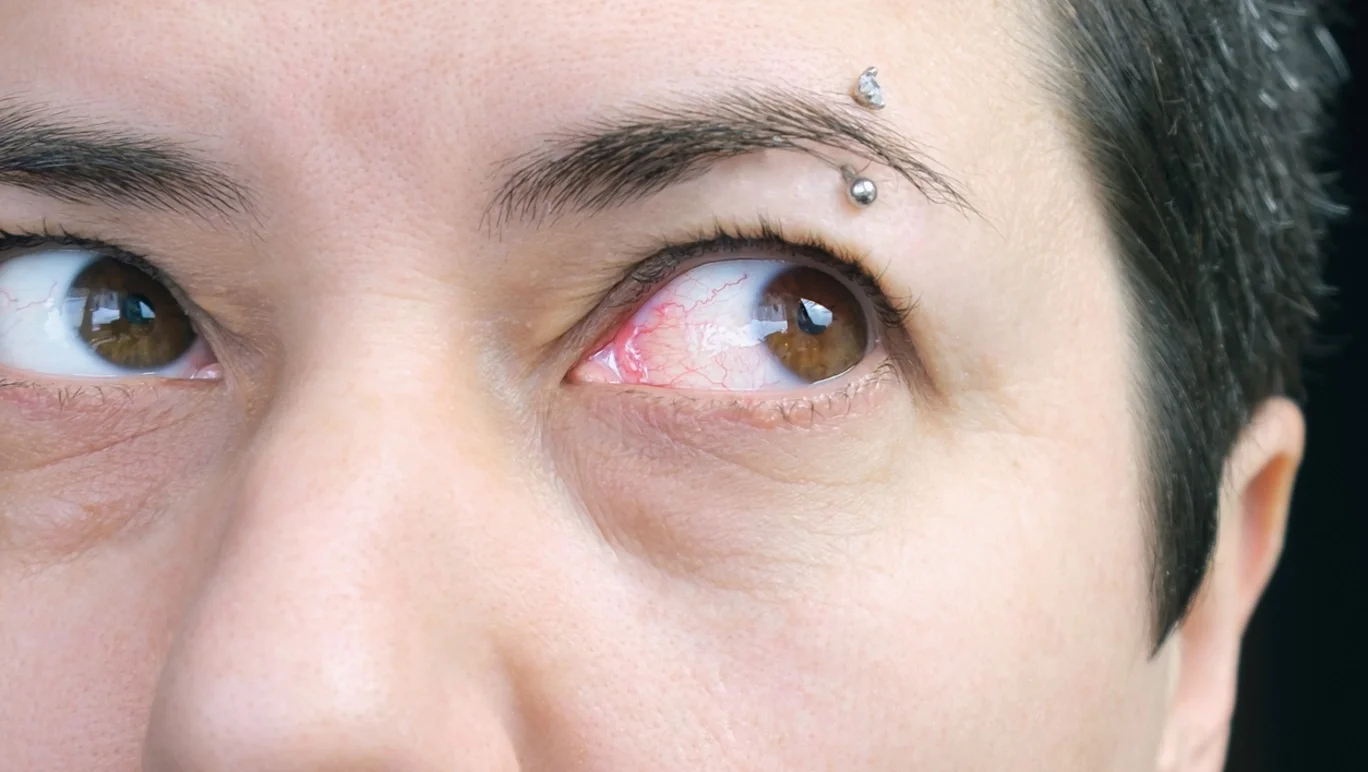Red-eye is a common term to describe red, bloodshot eyes. Usually, if the whites of the eyes have red veins in them, it is due to fatigue, lack of sleep, viral infection or irritation. If obvious red blood vessels persist it could point to an underlying medical condition or infection. Before trying to get rid of them you should first try to figure out why they might be there.
Bloodshot eyes
Bloodshot or red eyes occur when small blood vessels that are present on the surface of the eye become enlarged and congested with blood. This happens due to a reduced amount of oxygen being supplied to the cornea or the tissues covering the eye. The appearance of red-eye ranges in severity from a bright red that completely covers the sclera to a few enlarged blood vessels that look like wiggly red lines across the white of the eye.
Symptoms of red eye
Red eyes can occur in one or both eyes and may be accompanied by:
- eye pain
- itching
- eye discharge
- swollen eyes
- visual disturbances such as blurry vision
- or there may be have no irritation at all
Common causes of red veins in the eyes
Red blood vessels that are obvious in the sclera can be due to many different causes—here are some of the most common causes.
Contact lenses
One of the main causes of eye irritation and redness is over-wearing or not properly caring for your contact lenses. This can cause a build-up of irritating surface deposits and microbes on your eye.
If your eyes become bloodshot while wearing contact lenses, remove your contacts immediately and visit your eye doctor.
Allergies
An allergic reaction to dust, pollen, animal hair or mould can lead to red blood vessels in the eyes. If you have hay fever the eyes are usually itchy and irritated and you might have other symptoms such as sneezing and nasal congestion.
Dry eyes
If you don’t have enough lubrication in the eye this can lead to irritation, redness and a gritty sensation. If dry eyes are a chronic problem, this could indicate Sjogren’s syndrome which is an autoimmune condition that affects the tear ducts.
Click Here for further reading
Conjunctivitis
Conjunctivitis is one of the most common and contagious eye infections, particularly among school children.
It occurs when the conjunctiva becomes infected. The conjunctiva is the thin, normally transparent membrane that covers the sclera and lines the eyelids. When the conjunctiva is infected, the blood vessels within it become irritated and swell, giving the eye a red or pink appearance. In fact, a reddish-pink eye is a tell-tale symptom of conjunctivitis.
Click Here for further reading
Eye injuries
Trauma or injury to the eye can result in red, bloodshot eyes. As an inflammatory response to injury, blood vessels in your eye dilate to allow more blood flow to the site of the injury for quicker healing. This dilation (and sometimes breakage) of blood vessels on the eye is what causes the redness.
Eye injuries can range from minor eye scratches (corneal abrasions) to deep puncture wounds and chemical burns. Whatever the source, always treat an eye injury as a medical emergency and see an eye doctor immediately.
Treatment suggestions
Contact lenses
You can minimize your risk of contact lens-induced red eye by keeping your lenses clean and disinfected and replacing them according to your eye doctor's directions. Your doctor also may advise you to try daily disposable lenses or a different type of contact lens material, such as gas permeable lenses.
Allergy support
In this instance, most people would reach for an antihistamine medication or eye drop to provide relief. Other alternatives include taking a natural anti-allergy product that contains zinc, vitamin D, quercetin, perilla or albizzia.
Eye drops
What eye drop you select will depend on the cause of your symptoms. Usually, a lubricating eye gel or drop can assist in relieving the redness and uncomfortable symptoms of dry eyes. If there is an infection, you could try an eye drop with manuka honey. For allergies which affect the eyes, there are specific eye formulations for these symptoms.
Fish oil
Supplementing with fish oil has in a meta-analysis of randomised controlled studies to be an effective treatment for dry eye syndrome. Fish oil is rich in omega-3 which reduces inflammation and helps support natural tear production.
Blood vessel support
The blood vessels in our eyes are delicate and prone to breakages. To support healthy capillaries in the eyes consider taking:
- bilberry
- vitamin C
- bioflavonoids
- vitamin E
All these nutrients are antioxidants which prevent eye inflammation, support healthy circulation and boost immunity to provide protection against infection. Oligomeric Proanthocyanidins (OPCs) are the active ingredient found in grape seed extract. They help strengthen the capillaries and preventing blood vessel leakage.
Eye bath
If there is infection or irritation in the eye which is causing visible redness you could try an eye bath with drops of calendula and eyebright. Make sure you make up a different solution for each eye and that the water and equipment used is sterilized correctly.
Warm compress
Placing a heat pack or warm washer over the eyes can bring relief to dry, irritated eyes. The heat promotes circulation and stimulates natural oil production to lubricate the eyes. Repeat as often as needed throughout the day. In contrast to a warm compress apply a cold tea bag or cloth over the eyes to reduce inflammation and itchiness.
References
- https://www.medicalnewstoday.com/articles/316179.php
- https://www.healthline.com/health/eye-health/how-to-get-rid-of-red-eyes#shortterm-solutions
- Ariano R. Efficacy of a novel food supplement in the relief of the signs and symptoms of seasonal allergic rhinitis and in the reduction of the consumption of anti-allergic drugs. Acta Biomed. 2015 Apr 27;86(1):53-8 https://www.ncbi.nlm.nih.gov/pubmed/25948028
- Liu A, Ji J. Omega-3 essential fatty acids therapy for dry eye syndrome: a meta-analysis of randomized controlled studies. Med Sci Monit. 2014 Sep 6;20:1583-9 https://www.ncbi.nlm.nih.gov/pubmed/25193932
- Monograph. Vaccinium myrtillus (bilberry). Altern Med Rev. 2001 Oct;6(5):500-4. https://www.ncbi.nlm.nih.gov/pubmed/11703171
